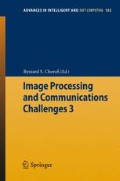Summary
The most hand gestures used in Human Computer Interaction (HCI) are generated either by one hand or by two hands on condition that both hands do not pass each other. This constraint in the two-hands gestures is due to the difficulties in reacquiring both hands correctly at the end of the hand-hand occlusion. In this paper, we provide a solution to this issue based on the fact that the appearance of both hands could not be changed entirely during the occlusion period.
Access this chapter
Tax calculation will be finalised at checkout
Purchases are for personal use only
Preview
Unable to display preview. Download preview PDF.
References
Elmezain, M., Al-Hamadi, A., Michaelis, B.: Real-time capable system for hand gesture recognition using hidden markov models in stereo color image sequences. The Journal of WSCG 16, 65–72 (2008), ISSN: 1213-6972
Caifeng, S., Tieniu, T., Yucheng, W.: Real-time hand tracking using a mean shift embedded particle filter. Pattern Recognition 40(7), 1958–1970 (2007)
Wachs, J., Stern, H., Edan, Y., Gillam, M., Feied, C., Smith, M.: Handler: A hand-gesture sterile tool for browsing mri images in the or. Journal of the American Medical Informatics Association 15 (2008)
Suk, H.I., Sin, B.K., Lee, S.W.: Hand gesture recognition based on dynamic bayesian network framework. Pattern Recogn 43, 3059–3072 (2010)
Varga, E., Verlinden, J., Klaas, O., Langenhoff, L., Steen, D.V.D., Verhagen, J.: A study on intuitive gestures to control multimedia applications. In: Proceedings of the IADIS International Conference on Interfaces and Human Computer Interaction (2008)
Switzerl, M.V., Just, A., Marcel, S., Just, A., Marcel, S.: Two-handed gesture recognition (2005)
McAllister, G., McKenna, S.J., Ricketts, I.W.: Hand tracking for behaviour understanding. Image and Vision Computing 20(12), 827–840 (2002)
Shamaie, A., Sutherland, A.: Hand tracking in bimanual movements. Image and Vision Computing 23(13), 1131–1149 (2005)
Chen, F.S., Fu, C.M., Huang, C.L.: Hand gesture recognition using a real-time tracking method and hidden markov models. Image and Vision Computing 21(8), 745–758 (2003)
Schettini, R., Gasparini, F.: Skin segmentation using multiple thresholding. In: Internet Imaging VII, IS and T/SPIE, pp. 60610F-1–60610F-8. SPIE (2006)
Hu, M.K.: Visual pattern recognition by moment invariants. IEEE Transactions on Information Theory 8(2), 179–187 (1962)
Author information
Authors and Affiliations
Editor information
Editors and Affiliations
Rights and permissions
Copyright information
© 2011 Springer-Verlag Berlin Heidelberg
About this paper
Cite this paper
Saeed, A., Niese, R., Al-Hamadi, A., Michaelis, B. (2011). Solving the Hand-Hand Overlapping for Gesture Application. In: Choraś, R.S. (eds) Image Processing and Communications Challenges 3. Advances in Intelligent and Soft Computing, vol 102. Springer, Berlin, Heidelberg. https://doi.org/10.1007/978-3-642-23154-4_38
Download citation
DOI: https://doi.org/10.1007/978-3-642-23154-4_38
Publisher Name: Springer, Berlin, Heidelberg
Print ISBN: 978-3-642-23153-7
Online ISBN: 978-3-642-23154-4
eBook Packages: EngineeringEngineering (R0)

